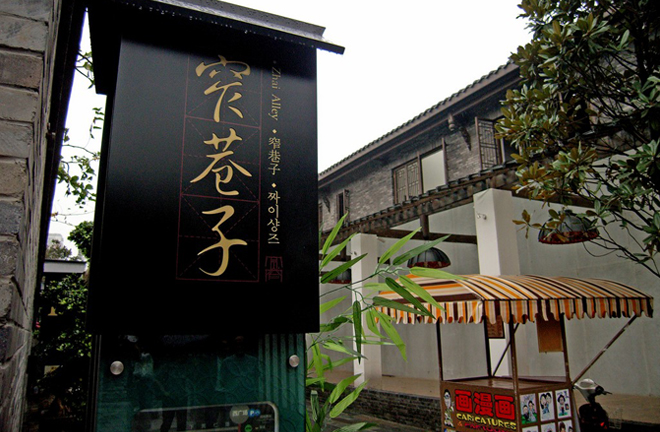Place names have hidden historical significance

Zhai Alley, or Zhaixiangzi, is an ancient street from the Qing Dynasty. It has been remodeled with a glossy veneer to match the cosmopolitan character of modern Chengdu.
Names of locations are clues to their history. Nanluoguxiang Alley in Beijing, Muslim Street in Xi’an, and Kuan Alley and Zhai Alley in Chengdu are examples of names that symbolize a distinct historical identity and have become celebrated tourist spots.
However, not all historical places shared this fortune. More of them exist only in archives and old people’s memories.
Connotations
In 2007, the ninth United Nations Conference on the Standardization of Geographical Names stipulated that geographic names can be considered intangible cultural heritage. In addition to acting as landmarks, these names have historical, cultural and social connotations, reflecting the unique temperament of a city. For example, place names such as Longtan Temple, Zhuge Liang Memorial Hall and Zilong Pond came from stories of the Three Kingdoms (220-280). Similar cases are common in other historic cities.
Wang Changsong, a professor from the School of Administration at the University of International Business and Economics, said that historical names connect people with their living environs, implying rich social memories.
This is evident in the personal experience of Zhu Rong, a professor from the School of Design at Jiangnan University, who offered her insights on historical names. She once went to Nanjing to look for a museum, and asked a resident about its specific location. The resident had no idea but a passerby reminded him that the museum had also been known as Ganxi Mansion. The case made Zhu realized that historical names are closely connected with people’s daily lives, historic memories and personal emotions, carrying a strong sense of culture.
Disappearance
However, in recent years, as urbanization has proceeded, great changes have taken place in city spaces and appearance. Quite a few old place names are disappearing, mainly in three ways. First, place names changed as spaces disappeared. Second, the characteristics of various spaces have been transformed, though the spaces still exist, thus the place names exist only as cultural symbols, and much of their significance vanishes as memories fade. Third, some place names changed in order to keep up with the times. For example, a street in Beijing called Jinchengfang Alley during the Yuan (1271-1368) and Ming (1368-1616) dynasties is now called Financial Street.
In addition, there is heavy Westernization of new place names. Various bizarre buildings sprang up, so historical names disappeared and have been gradually forgotten by citizens. Once they vanish in large numbers, we lose a vital part of our memories about the cities.
Protection
Many cities, and cities with a rich historical legacy in particular, have started to carry out proposals to protect these names. For example, the Beijing municipal government issued the Urban Toponymic Plan (Trial Implementation) in 2009, and Chengdu carried out Overall Planning on Place Names (2015-2020) in 2015. Suzhou, Xi’an, Nanjing and Yangzhou are all taking similar actions.
Protection of historical geographic names should be considered a part of urban planning. Overall investigation of these names should be conducted in order to clarify the history and current conditions of these places, classifying and listing them for proper protection.
In addition, constructing an atmosphere for protection is essential for the public to appreciate the importance of the culture of place names, as well as the historical and literal meanings for protection. Related lectures, forums and Internet resources can be used to aid this process. Nameplates can also be built at the spots where the old names are gone to tell people the connotations of the old names and the origins of the current ones.
Also, these historical names cannot all be dealt with using the same standards, or all in a conservative way. On the contrary, they should be treated according to their historical value and current conditions. When a location is of little cultural or historical significance, change is acceptable, but when it comes to vital areas, their names must be treated carefully.
Que Weimin, a professor from the College of Urban and Environmental Sciences at Peking University, said that protection of historical geographic names is an important part of urban place name management. He said that where possible, names should be recovered carefully to avoid confusion.
Zhang Chunhai is a reporter at the Chinese Social Sciences Today.

 PRINT
PRINT CLOSE
CLOSE